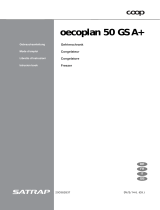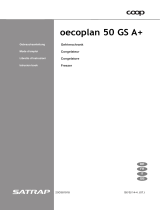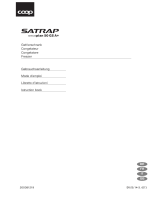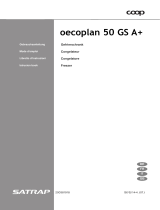Page is loading ...

38
Before installing and using the appliance read this user's instruction book carefully. It contains safety
precautions, hints, information and ideas. If the refrigerator is used in compliance with the
instructions written, it will operate properly and provide you with greatest satisfaction.
The symbols below help you to find things more easily:
Safety precautions
Warnings and information at this symbol serve safety for you and your appliance.
Hints, useful information
Environmental information
Symbol for ideas
At this symbol ideas can be found according to food and its storing.
The symbol on the product or on its packaging indicates that this product may not be treated
as household waste. Instead it shall be handed over to the applicable collection point for the
recycling of electrical and electronic equipment. By ensuring this product is disposed of
correctly, you will help prevent potential negative consequences for the environment and
human health, which could otherwise be caused by inappropriate waste handling of this
product. For more detailed information about recycling of this product, please contact your
local city office, your household waste disposal service or the shop where you purchased the
product.
GB

39
GB
Cont
Cont
ents
ents
Important safety information ..................................................................................................40
General safety precautions....................................................................................................40
Precautions for child safety....................................................................................................40
Safety precautions for installation ...........................................................................................40
Safety precautions for isobutane ............................................................................................40
Instructions for the User .........................................................................................................41
General information ..............................................................................................................41
Description of the appliance, main parts ..................................................................................41
Instructions for the Installer....................................................................................................42
Technical data .....................................................................................................................42
Installing the appliance .........................................................................................................42
Transportation, unpacking.................................................................................................42
Cleaning ........................................................................................................................42
Placement......................................................................................................................42
Handling the appliance .........................................................................................................43
Putting it into use.............................................................................................................43
Controlling the temperature, setting....................................................................................43
Hints for storage..............................................................................................................44
Storage time and temperature of foods ..............................................................................44
How to use the ice-making compartment.............................................................................44
How to use the fresh food compartment..............................................................................45
How to make ice cubes ....................................................................................................45
Some useful information and advice........................................................................................45
Hints and ideas ...............................................................................................................45
How to save energy .........................................................................................................45
The appliance and environment .........................................................................................45
Maintenance .......................................................................................................................45
Defrosting ......................................................................................................................45
Regular cleaning .............................................................................................................46
When the refrigerator is not in use......................................................................................46
Trouble shooting..................................................................................................................46
Change of door opening direction ......................................................................................47
Electrical connection........................................................................................................47
Storage time chart.................................................................................................................48
Warranty and service .............................................................................................................49
Guarantee conditions ...........................................................................................................49
Service and spare parts........................................................................................................49

40
GB
Im
Im
por
por
t
t
ant saf
ant saf
et
et
y inf
y inf
ormation
ormation
Precautions for child safety
Do not allow children to play with the packaging of
the appliance. Plastic foil can cause suffocation.
Adults must handle the appliance. Do not allow
children to play with it or its controlling parts.
If you are discarding the appliance pull the plug out
of the socket, cut the connection cable (as close to
the appliance as you can) and remove the door to
prevent playing children to suffer electric shock or
to close themselves into it.
Safety precautions for
installation
Put the appliance to the wall to avoid touching or
catching warm parts (compressor, condenser)
to prevent possible burn.
When moving the appliance take care of the plug
not to be in the socket.
When placing the appliance take care not to
stand it on the power cord.
Adequate air circulation should be around the
appliance, lacking this leads to overheating. To
achieve sufficient ventilation follow the
instructions relevant to installation.
If the appliance is not placed on floor level,
provide appropriate fixing (e. g. using sucking
disks).
See chapter "Placement".
For the safety of life and property keep
the precautions of these user's
instructions as the manufacturer is not
responsible for damages caused by omission.
General safety precautions
Keep these instructions and they should remain at
the appliance when moving away or changing
owner.
This appliance is designed for storing food,
domestic use and being used according to these
instructions only.
Specialised companies that are qualified to do
so by the manufacturer must carry out service
and repairs including repairing and changing
the power cord. Accessory parts supplied by
them should be used only for repairing. Otherwise
the appliance can be damaged or can cause other
damage or injury.
The appliance is out of circuit only in that case if the
plug is removed from the socket. Before cleaning
and maintenance always unplug it (do not get it by
the cable). If the socket is difficult to reach, switch
off the appliance by cutting off the current.
Power cord must not be lengthened.
When cleaning, defrosting, taking out frozen food
or ice tray do not use sharp, pointed or hard
devices, as they can cause damage to the
appliance.
Be careful not to allow liquids to the temperature
control.
Ice and ice-cream can cause hurt if they are eaten
immediately after removal from the ice-making
compartment.
After dissolving frozen food must not be refrozen, it
must be used up as soon as possible.
Store pre-packed frozen food in accordance with
the frozen food manufacturer's instructions.
You must not make defrosting faster with any
electric heating appliance or chemicals.
Do not put hot pot to the plastic parts of the freezer.
Do not store flammable gas and liquid in the
appliance, because they may explode.
Do not store carbonated drinks, bottled drinks and
bottled fruits in the freezer.
Safety precautions for
isobutane
Warning
The refrigerant of the appliance is isobutane
(R600a) that is inflammable and explosive to a
greater extent.
Keep ventilation openings, in the appliance
enclosure or in the built-in structure, clear of
obstruction.
Do not use mechanical devices or other means
to accelerate the defrosting process, other than
those recommended by the manufacturer.
Do not damage the refrigerant circuit.
Do not use electrical appliances inside the food
storage compartments of the appliance, unless
they are of the type recommended by the
manufacturer.
This appliance is not intended for use by
persons (including children) with reduced
physical sensory or mental capabilities, or lack
of experience and knowledge, unless they have
been given supervision or instruction
concerning use of the appliance by a person
responsible for their safety.

41
GB
Ins
Ins
tr
tr
uctions f
uctions f
or the User
or the User
General information
The official designation of the appliance is home
refrigerator with a ice-making compartment.
According to this the appliance is suitable for storing
frozen and deep-frozen food for limited time and
making ice.
The appliance can meet the requirements of
standards between different temperature limits
according to the climate class.
The letter symbol for class of climate can be found
on the data label.
Description of the appliance, main parts
1. Ice-making compartment
2. Data plate
3. Ice tray
4. Wire shelf
5. Drip tray
6. Feet
7. Door gasket
8. Door compartment
9. Thermostat with knob
10. Condenser
11. Air circulation
12. Compressor
13. Spacer
5
1
2
3
4
6 7 8
9
11
13
12
10

42
GB
Ins
Ins
tr
tr
uctions f
uctions f
or the Ins
or the Ins
t
t
aller
aller
Technical data
OECOPLAN 67 KS A+
Ice-making comp.: 5
Fresh food comp.: 65
Ice-making comp.: 5
Fresh food comp.: 62
525
520
587
0,299
109
A+
0,6
24
Model
Gross capacity (l)
Net capacity (l)
Width (mm)
Height (mm)
Depth (mm)
Energy consumption (kWh/24h)
(kWh/year)
Energy class, according to EU standards
Rated current (A)
Weight (kg)
Installing the appliance
Transportation, unpacking
It is recommended to deliver the appliance in
original packaging, in vertical position
considering the protective warning on packaging.
After each transportation the appliance must not be
switched on for approx. 2 hours.
Unpack the appliance and check if there are damages
on it. Report possible damages immediately to the
place you bought it. In that case retain packaging.
Cleaning
Remove every adhesive tape, which ensure the parts
not to move in the appliance.
Wash the inside of the appliance using lukewarm
water and mild detergent. Use soft cloth.
After cleaning wipe out the inside of the appliance.
Placement
The ambient temperature has an effect on the energy
consumption and proper operation of the appliance.
When placing, take into consideration that it is
practical to operate the appliance between ambient
temperature limits according to the climate class that
is given in the chart below and can be found in the
data label.
Class of climate
SN
N
ST
Ambient temperature
+10 ... +32 °C
+16 ... +32 °C
+18 ... + 38 °C

43
GB
If the ambient temperature goes below the lower data
the temperature of the cooling compartment can go
beyond the prescribed temperature.
If the ambient temperature goes beyond the upper
data this means longer operating time of the
compressor, increasing temperature in the cooling
compartment or increasing energy consumption.
When placing the appliance ensure that it stands level.
Mount the spacers supplied in the plastic bag of
the accessories. Hold the spacer as shown on the
Fig., using fine strokes of hammer put it in its
place.
Do not stand the appliance on a sunny place or close
to a radiator or cooker.
If it is unavoidable because of furnishing and the
appliance has to be stood near a cooker take these
minimum distances into consideration:
In case of gas or electric cooker 3 cm must be left,
when it is less put a 0,5 - 1 cm non-flam insulation
between the two appliances.
In case of oil or coal-fired stove the distance must
be 30 cms since they give off more heat.
The refrigerator is designed to operate when it is
totally pushed to the wall.
When placing the refrigerator keep minimal
distances recommended in figure.
A : placing it under a wall-cupboard
B : placing it freely
Handling the appliance
Putting it into use
Place the accessories into the refrigerator then plug to
the mains socket. To start cooling turn the control dial
from "0" clockwise according to the figure. In „0”
position the appliance is out of operation.
The next paragraph will give instructions for setting.
Controlling the temperature, setting
The thermostatic controller interrupts the operation of
the appliance automatically for more or less time
depending on the setting then restarts it assuring the
required temperature.
Turning the control button towards the bigger numbers
cooling becomes more and more intensive.
In the ice-making compartment can be reached -2 °C
or lower temperature if the knob of the thermostatic
control is set according to following table:
Ambient temperature Thermostat setting
from 10 °C to 16 °C „1”
from 16 °C to 25 °C „1-2”
from 25 °C to 32 °C „2-3”
from 32 °C to 38 °C „3-4”
In this case the temperature starting automatically in
the fresh food compartment is about +5 °C or below.

44
GB
The setting 5., 6. and 7. are suitable for quick chill of
big quantity goods.
The temperature coming about in the refrigerator is
effected by not only the position of the thermostatic
control but the ambient temperature, frequency of
door openings and the quantity of food put into it
newly etc.
In the maximum i.e. „7” position - in case of
increased demand e.g. during heatwaves -
without disconnecting continuous operation can
occur. This does not cause damages to the appliance.
Hints for storage
When placing the different kinds of food take into
consideration the sketch below in figure:
1. Storing frozen foods, making ice and ice-cream.
2. Confectionery, ready-cooked foods
3. Foods in dishes
4. Opened cans
5. Milk, dairy products
6. Fresh meat, cold cuts, sausages, etc.
7. Fruits, vegetables, salads
8. Cheese, butter
9. Eggs
10. Yoghurt, sour cream
11. Bottles, drinks
Storage time and temperature of
foods
The enclosed chart at the end of the instruction books
gives information about storage time in the fresh food
compartment.
The storage time can not be determined exactly in
advance, as it depends on the freshness and handling
of the cooled food. That is why the storage time made
known is only informative.
It is safe to store quick-frozen food only that way if they
were not dissolved even for a short time until placing
them into the ice-making compartment.
How to use the ice-making
compartment
In the ice-making compartment -2 °C or below can be
held depending on setting of thermostatic control.
It is suitable for quickly refrigerating and storing foods
in small quantity and for making ice-cubes.

45
GB
How to use the fresh food
compartment
For adequate cooling developing interior air
circulation is necessary. For this reason you are
asked not to cover the whole surface of the wire
shelves with paper, trays, etc.
Do not put hot food into the refrigerator.
Allow it to reach room temperature naturally.
In this way the unnecessary frost building up can
be avoided.
Foods can take over odours from each
other. So it is essential to put foods in closed
dishes or wrap them in cellophane, aluminium
foil, grease-proof paper or cling film before
placing them into the refrigerator. This way foods
will keep their moisture e.g. vegetables will not
dry out after some days.
How to make ice cubes
To make ice cubes fill the enclosed ice cube tray with
water and put it to the ice-making compartment or on
top of it. Wetting the bottom of the tray and setting
thermostatic control knob to maximum stage can
shorten preparing time. After finishing do not forget to
reset the thermostatic control to the suitable stage.
In case of no room for ice tray ice cubes can be made
and/or stored on top of ice-making compartment.
For purchasing further ice trays contact your local
dealer.
Ready ice cubes can be taken out of the tray under
running water then twist or hit it.
Hints and ideas
In this chapter practical hints and ideas are given
about how to use the appliance to reach maximum
energy saving and there is environmental information
about the appliance as well.
How to save energy
Avoid putting the appliance in a sunny place and
near anything that gives off heat.
Be sure that the condenser and the compressor
are well ventilated. Do not cover the sections where
ventilation is.
Some useful information and
advice
The shelf inside the appliance has a back-folding part
on the left side that makes storing large-sized bottles
possible.
Top doorshelves taken out of the appliance can be
used for serving foods (fruit, salads, etc.).
Two doorshelves put together can be used for storing
foods in or outside the appliance (e.g. on excursions).
Wrap products in tightly closing dishes or cling
film to avoid building up unnecessary frost.
Do not leave the door open longer than
necessary and open it when it is needed.
Put liquid into the appliance only in a closed
dish.
Put warm foods and liquid in the appliance only
when they are at room temperature.
Defrost the appliance when the ice in the
ice-making compartment is more than 4 - 5
mm thick.
Keep the condenser clean.
The appliance and environment
This appliance does not contain gasses which
could damage the ozone layer, in either its
refrigerant circuit or insulation materials. The
appliance shall not be discarded together with the
urban refuse and rubbish. Avoid damaging the
cooling unit, especially at the rear near the heat
exchanger. Information on your local disposal sites
may be obtained from your municipal authorities.
The materials used on this appliance marked with
the sympol are recyclable.
Defrosting
Bleeding part of the moisture of cooling chamber in
form of frost and ice goes with the operation of the
refrigerator.
Thick frost and ice has an insulating effect, so it
reduces cooling efficiency as the temperature
increases, it needs more energy, at a certain
thickness it does not allow the door of the ice-
making compartment to open, possibly the door
can be broken.
We recommend to defrost the ice-making
compartment once a week and when the
frost is more than 4-5 mm.
How to defrost it:
Break the circuit of the appliance or turn
thermostatic control knob into „0” position.
Empty the ice box. Wrap foods inside into
newspaper and put them on a cool place or into
another appliance.
Leave the door of the appliance and ice-making
compartment open.
Defrosting usually takes several hours. When
finished, pour defrost water gathered out of the tray
and wipe the surfaces dry.
Apply voltage to the appliance or turn thermostatic
control knob to middle („4”) position.
Put foods taken out back to their places.
Maintenance

46
GB
Regular cleaning
It is recommended to wash the inside of the
refrigerator in 3-4 weeks time.
Household cleaner or soap must not be used.
After you made it no-current wash the appliance using
lukewarm water and wipe it.
Clean the magnet door rubber profile with clean water.
After cleaning plug the appliance to the mains socket.
It is practical to clean and defrost the ice-making
compartment at a time and when it is empty.
Dust and dirt collected on the back of the refrigerator,
condenser is recommended to be removed once or
twice a year.
When the refrigerator
is not in use
In case the appliance will not be used for a long time
follow these steps:
Break the circuit of the appliance.
Remove foods from the refrigerator.
Defrost and clean it as written before.
Leave the door open to avoid a build up of air inside.
Trouble shooting
During operation of the appliance some smaller but
annoying trouble can often occur, which does not
require calling a technician out. In the following
chart information is given about them to avoid
unnecessary charges on service.
We draw your attention that operation of appliance
goes with certain sounds (compressor- and
circulating sound). This is not trouble, but means
normal operation.
We draw it to your attention again that the
appliance operates discontinuously, so the
stopping of compressor does not mean
being no-current. That is why you must not touch
the electrical parts of the appliance before
breaking the circuit.
Problem
The appliance does not
cool sufficiently
The appliance cools too
hard
The appliance does not
cool at all
The appliance is noisy
Possible cause
The thickness of the frost is greater than 4-5 mm on
the cooling plate.
Thermostatic control is set too low.
Too many foods to be cooled were put in.
Very warm foods were put in.
Door is not shut properly.
There is no inside cool air circulation.
The thermostatic control is set too high.
Plug is not connected to the mains socket properly.
There is no voltage in the mains socket.
Thermostatic control is in „0” position.
The appliance is not supported properly.
Solution
Defrost the appliance.
Set higher position.
Put fewer foods to be cooled.
Put foods max. at room temperature.
Check if the door is shut.
Provide inside cool air circulation.
Set lower position.
Check if the connection is proper.
Check if there is voltage.
Check setting of thermostatic control.
Check if the appliance stands stable.
Inasmuch as the advice does not lead to result, call the nearest brand-mark service.

47
GB
Change of door opening direction
Should the setting-up or handling demand it, door-
opening direction can be refitted from right-handed to
left-handed.
Following operations are to be done on the basis of
figures and explanations:
Break the circuit of the appliance.
Take the covering of top door holder off, unscrew
the screws fixing the top door holder (2 pieces) and
take it off according to figure.
Take the door off.
Remove the screw fixing the lower door holder and
the other screw fixing the lower door holder and the
foot. Then remove the door holder and the foot as
shown in the Figure.
Loosen the screw fixing the foot opposite the lower
door holder in order to remove the foot.
Fix the door holder and the corresponding foot on
the opposite side and then the other loosened foot
at the former place of the door holder as shown in
the Figure.
Please make sure to place the lower foot
below the door holder. The lower foot is
recognizable by its 4 ribs on the outer surface.
Fit the door to the lower door holding pin.
To fit top door holder remove plastic coverings of
door holder holes carefully (e. g. with a knife) and
put them on the other side.
Fix top door holder with 2 screws in the place set
free being careful that the edge of the door is
parallel with the side of cupboard.
Put the covering of top door holder back.
Put over the handle and the plastic nails on the
other side.
In case you do not want to perform the procedures
above, call the nearest brand-mark service.
Technicians will accomplish the refitting expertly for
charge.
Electrical connection
This refrigerator is designed to operate on a
230 V AC (
~
) 50 Hz supply.
The plug must be put into a socket with protective
contact. If there is no such, it is recommended to
get an electrician to fit an earthed socket in
compliance with standards near the refrigerator.
This appliance complies with the following
E.E.C. Directives:
– 73/23 EEC of 19.02.73 (Low Voltage Directive)
and subsequent modifications,
– 89/336 EEC of 03.05.89 (Electromagnetic
Compatibility Directive) and subsequent
modifications,
– 96/57 EEC - 96/09/03 (Energy Efficiency
Directive) and its subsequent amendments.

48
GB
Foods Storage time in days Method of packaging
1234567
Raw meat XXx x x cling film, airtight
Cooked meat XXXx x x dish covered
Roasted meat XXXx x dish covered
Raw minced meat X dish covered
Roasted minced meat XXx x dish covered
Cold cuts, Vienna sausage XXx x cling film, cellophane, grease-proof paper
Fresh fish X x x cling film, airtight
Cooked fish XXx x dish covered
Fried fish XXx x x dish covered
Tinned fish, open X x x dish covered
Fresh chicken XXXx x x cling film, airtight
Fried chicken XXXx x x dish covered
Fresh hen XXx x x cling film, airtight
Boiled hen XXx x x dish covered
Fresh duck, goose XXXx x x cling film, airtight
Roasted duck, goose XXXXx x x dish covered
Butter unopened XXXXXXXoriginal packaging
Butter opened XXxxxxxoriginal packaging
Milk in a plastic bag XXXx x original packaging
Cream XXx x plastic box
Sour cream XXXXx x x plastic box
Cheese (hard) XXXXXXXaluminium foil
Cheese (soft) XXXXx x x cling film
Curds XXXXx x x cling film
Egg XXXXXXX
Spinach, sorrel XXx x cling film
Green peas, green beans XXXXx x x cling film
Mushroom XXx x x cling film
Carrot, roots XXXXXXXcling film
Bell-pepper XXx x x cling film
Tomato XXXXXXXcling film
Cabbage XXXXXx x cling film
Quickly rotting fruits
(strawberry, raspberry, etc.) XXXx x cling film
Other fruits XXXXx x x cling film
Tinned fruits opened XXXx x dish covered
Cakes filled with cream XXx x dish covered
S
S
t
t
or
or
age time char
age time char
t
t
Time and method of storage of fresh foods in the refrigerator
Notation:
X usual storage time
x possible storage time (concerns to really fresh product only)

49
GB
W
W
ar
ar
r
r
ant
ant
y and ser
y and ser
vice
vice
Guarantee conditions
Service and spare parts
If calling the service is unavoidable, announce the
trouble at a brand-mark service nearest to your place.
When announcing the appliance has to be identified
according to its data label.
The data label of the appliance is stuck to the wall of
the interior beside the vegetable box in the fresh food
compartment in the bottom on the left side. All
necessary data are there which are needed to the
service announcement (type, model, serial number,
etc.). Note here the data from the data label of your
appliance:
Model
Product No.
Serial No.
Date of purchase:
The manufacturer reserves the right to make any changes in the products.

Info Service
Postfach 2550, 4002 Basel
Info - Tel. 0848 888 444*
www.coop.ch
*Tarif interurbain/Fernbereich/Area discosta
Servicestelle Wangen
Postfach
4612, 4002 Wangen bei Olten
Telefon 062 206 33 55
Fax 062 206 33 12
Service après-vente
Ch. Veyre-d’en-Haut
1806 St-Légier
Fax 021 652 37 88
Service-Hotline 0848 811 222
/








